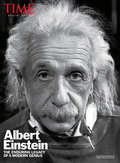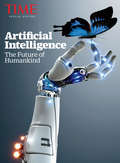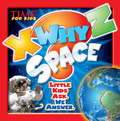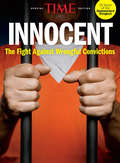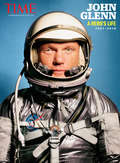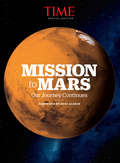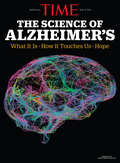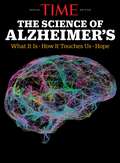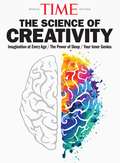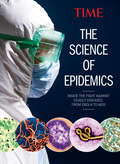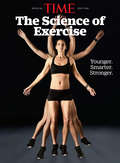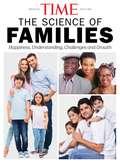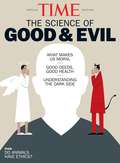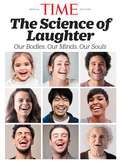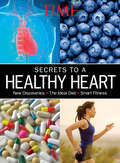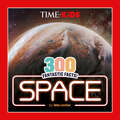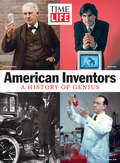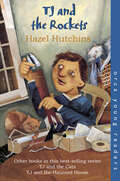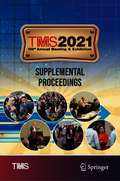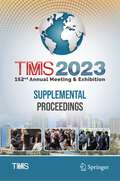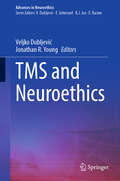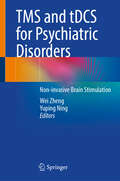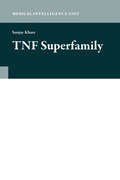- Table View
- List View
TIME Albert Einstein: The Enduring Legacy of a Modern Genius
by The Editors of TIMEAlbert Einstein's immense breakthroughs in theoretical physics revolutionized our view of the cosmos and made him one of the towering figures of the 20th century, a man whose name is synonymous with genius.
TIME Artificial Intelligence: The Future of Humankind
by The Editors of TIMEThe future of humankindArtificial intelligence has moved beyond science fiction and into reality, changing history and touching our lives in so many ways-from how astronomers explore the edges of our universe to whether your music system understands the difference between John Legend and John Lennon. Digital assistants such as Siri and Alexa as well as the next generation of smartphones, genomic research, instant language translation and self-driving cars all incoporate artificial intelligence. In this new special edition from TIME, Artificial Intelligence: The Future of Humankind, readers delve into this fascinating field, with authoritative essays and infographics and compelling images of the machines, the science and the people that are changing the course of the future. With a history of A.I., a glossary of the terms that will soon become commonplace, a detailed Q&A and focused articles on how A.I. is changing entertainment, education, technology, communication-and everything else-TIME: Artificial Intelligence is your guide to the future.
TIME For Kids X-WHY-Z Space: Kids Ask. We Answer
by Mark Shulman James Buckley Jr.TIME FOR KIDS brings you the third title in the highly successful X-WHY-Z series. These colorful pages will introduce children ages 4 to 6 to the natural wonders of space, with beautiful images and simple text that is perfect for beginning readers or for reading along. The book will explain basic concepts of planets, stars, asteroids and space ships, beginning with what is most familiar to kids and expanding throughout the universe.
TIME Innocent: The Fight Against Wrongful Convictions
by The Editors of TIMETIME looks at those wrongfully convicted, and the fight to set them free.
TIME John Glenn: A Hero's Life
by The Editors of TIMEOn Feb. 20, 1962, astronaut John Glenn spent four hours and 56 minutes in space, orbiting Earth three times in one of the most highly anticipated events in American history. The thrilling mission propelled the U.S. in its space race against Russia, and Glenn became a national hero the moment he splashed down in the Atlantic. He followed that with an extraordinarily rich and productive life, serving four terms as an Ohio senator and, remarkably, returning to space at age 77 in 1998. This riveting, lavishly illustrated 100-page special edition of TIME brings Glenn, and his signature achievements, to life through an unmatched level of journalism. Among the highlights:Original real-time reporting of GlennÍs astounding spaceflight and the Mercury 7The beautiful love story of John and Annie Glenn, married for 73 yearsA timeline chronicling manÍs progress in outer spaceThe Right Stuff: GlennÍs exceptional makeup from Tom WolfeÍs classic bookGlenn as statesman: TIME assesses the astronautÍs political legacy
TIME Mission to Mars: Our Journey Continues
by Buzz Aldrin The Editors of TIMEThe prospect of sending a manned mission to Mars and even colonizing the planet is capturing the imagination of NASA and space entrepreneurs. A noble goal, or an expensive folly? TIME's special edition takes you inside the science and the debate. Just getting to Mars will be an amazing technical feat, traveling 35 million miles on a nine-month journey. This edition explores:* How American astronaut Scott Kelly spent a year on the International Space Station to measure the effects of prolonged space travel* The exciting technology being developed to make the journey to Mars* Buzz Aldrin's plans for establishing a permanent settlement on the Red Planet
TIME The Science of Alzheimer's
by Editors of TIMEConfusing, mysterious and unknown, Alzheimer's is among the most-feared diseases because it strikes indiscriminately and there is no known cure. Now, in The Science of Alzheimer's, a new Special Edition from the editors of TIME, we draw back the curtain to reveal the latest research on what the disease is and what it is not, and how science is working to make Alzheimer's a manageable problem with a hopeful long-term prognosis, akin to diabetes or HIV. Go inside the latest research on different types of dementia, hereditary and environmental causes, new treatments, and more. Helpful lifestyle tips show how to ward off mental decline as we age, and case histories-including the stories of musician Glen Campbell and President Ronald Reagan, who bravely shared their diagnoses with the world-reveal the human face of Alzheimer's. We also look at the latest drugs being used to treat the disease and how there is hope in recent treatments and protocols, as well as alternative treatments that may be making a difference. Packed with authoritative information from the health editors at TIME, this guide helps everyone understand a frightening disease-and recognize the strides that are being made to fight it.
TIME The Science of Alzheimer's
by The Editors of TIMEIn TIME's The Science of Alzheimer's learn more about this disease that steals the self as well as the human ingenuity and dogged persistence that gives us hope for the future in the fight against it.
TIME The Science of Creativity
by The Editors of TIMEFrom ancient drawings to the genius of Leonardo and Einstein to the imagination that colors our everyday life: the drive to create, innovate and make something new is a big part of what makes us human. Explore this and more in this new special edition from TIME, The Science of Creativity.
TIME The Science of Epidemics: Inside the Fight Against Deadly Diseases, from Ebola to Aids
by The Editors of TIMETIME's The Science of Epidemics brings deeper understanding of Ebola and other infectious diseases from plague to polio. TIME takes readers behind the headlines not only to look at what caused Ebola to spread, but how doctors are trying to fight the disease in Africa, what the US and other countries are doing to stop it from spreading and the impact it has on survivors and society. TIME looks into the battle against other diseases as well, including the campaign in Saudi Arabia against MERS-Middle East Respiratory Syndrome-and what doctors and scientists are doing to end the AIDS epidemic. TIME explores the work of virus hunters in the field, report on the new Enterovirus D68 and the ever-present and mutating flu virus, explain how science won the fight against polio, and chronicle the deadliest viruses of all time. Filled with the behind-the-scenes reporting people expect from Time, as well as the publication's magnificent photography and informative graphics, The Science of Epidemics is a book illuminates what medical researchers and doctors in the field are doing to save millions of lives from deadly diseases.
TIME The Science of Exercise: Younger. Smarter. Stronger
by The Editors of TIMEFew fields have changed as rapidly as the science of exercise. New research suggests that exercise can increase your life expectancy and stave off cognitive decline more than anything else you do. The best part? You may not need to do as much of it as experts once thought. In this TIME special edition, readers will learn:exactly why exercise is the best anti-ager-and how it changes nearly every part of the bodyeffective ways to squeeze tiny amounts of exercise into your daystrategies for lasting weight loss through exercise in conjunction with the right dietthe best exercises for every goal, whether it's stress reduction, better skin, a stronger stomach or a healthier heart
TIME The Science of Families: Better Romance - Modern Families - True Friends
by The Editors of TIMEIn this special edition from TIME, The Science of Families, explore the evolution of the human family and all the life-events that effect it including adoption, childbearing, death, and more.
TIME The Science of Good and Evil
by The Editors of TIMETIME Magazine presents The Science of Good and Evil.
TIME The Science of Laughter
by The Editors of TIMEHave you ever wondered why we laugh? If giggling is contagious? If laughter really is the best medicine? Discover that and more in this special edition, TIMEThe Science of Laughter.
TIME The Secrets to a Healthy Heart
by Editors of TIMEHeart disease is America's No. 1 killer, causing one in every four deaths. Yet new science and time-tested strategies hold the keys to having a healthy heart. In this special edition, TIME shows the remarkable resiliency of this organ and the best ways to keep it in top shape for a lifetime. Highlights include:Astonishing new advances in treating heart diseaseThe strong connection between our emotions and our cardiovascular healthPromising new drugs and proven heart-healthy diets
TIME for Kids: 300 Fantastic Facts!: Space (TIME for Kids)
by Wes LocherLearn 300 fun facts about outer space, astronauts, planets, stars, moons, and more in this out-of-this-world book for young readers!This book is packed with exciting information about space! Learn 300 fascinating facts about planets, astronauts, stars, the sun, moons, space exploration, black holes, asteroids, rockets, rovers, and more in this awesome book for space lovers and armchair astronauts of all ages.
TIME-LIFE American Inventors: A History of Genius
by The Editors of TIME-LIFEFrom Thomas Edison to Alexander Graham Bell to Benjamin Franklin to Henry Ford to the Wright Brothers, our country has been built upon a foundation of innovation. A melting pot of diversity, America harbors a collaborative spirit and inspires an exchange of ideas where what is developed by one inventor is adopted by others and pushed further, improved, and perfected, fusing different perspectives together as one.In this all-new special edition from TIME LIFE, American Inventors chronicles those minds that transformed the worlds of Industry, Information, Home, Health, and Transportation and inspired generations to come. Learn more about the inventors that went down in history for their vision, dedication and perseverance in this celebration of American ingenuity. As automotive inventor and businessman Charles Kettering once put it, although "the world hates change, it is the only thing that has brought progress" and this nation is composed of a rich history of genius that continues to inspire progress each and every day.
TITAN Interior, Surface, Atmosphere, and Space Environment
by Ingo Müller-Wodarg Caitlin A. Griffith Emmanuel Lellouch Thomas E. CravensTitan, the largest of Saturn's moons, shares remarkable similarities with Earth. Its thick atmosphere is composed primarily of nitrogen; it features the most complex organic chemistry known outside of Earth and, uniquely, hosts an analog to Earth's hydrological cycle, with methane forming clouds, rain and seas. Using the latest data from the ongoing Cassini–Huygens missions, laboratory measurements and numerical simulations, this comprehensive reference examines the physical processes that shape Titan's fascinating atmospheric structure and chemistry, weather, climate, circulation and surface geology. The text also surveys leading theories about Titan's origin and evolution, and assesses their implications for understanding the formation of other complex planetary bodies. Written by an international team of specialists, chapters offer detailed, comparative treatments of Titan's known properties and discuss the latest frontiers in the Cassini–Huygens mission, offering students and researchers of planetary science, geology, astronomy and space physics an insightful reference and guide.
TJ and the Rockets (Orca Young Readers)
by Hazel HutchinsTJ overcame his fear of cats in TJ and the Cats and his fear of ghosts in TJ and the Haunted House. Now, he's not so keen on facing his fear of failure. His best friend Seymour is determined to come up with the latest greatest invention and TJ's gran expects TJ to build a rocket. The kittens, T-Rex and Alaska, are eager to get involved. When the first rocket that TJ builds plummets out of the sky, no parachute in sight, TJ is sure that his efforts are doomed. But are they?
TMS 2021 150th Annual Meeting & Exhibition Supplemental Proceedings (The Minerals, Metals & Materials Series)
by The Minerals, Metals & Materials SocietyThis collection presents papers from the 150th Annual Meeting & Exhibition of The Minerals, Metals & Materials Society.
TMS 2023 152nd Annual Meeting & Exhibition Supplemental Proceedings (The Minerals, Metals & Materials Series)
by The Minerals, Metals & Materials SocietyThis collection presents papers from the 152nd Annual Meeting & Exhibition of The Minerals, Metals & Materials Society.
TMS and Neuroethics (Advances in Neuroethics)
by Veljko Dubljević Jonathan R. YoungAs transcranial magnetic stimulation (TMS) continues to expand from a tool of neuroscience research into a growing array of clinical applications, it presents a number of open questions that both invite and complicate ethical evaluation. Empirically supported concerns remain regarding interactions between TMS and psychiatric medications or other interventions, the potential for adverse effects in stimulated brain regions, and whether modulation of brain activity—particularly via changes in oscillatory states—might affect aspects of personhood. This volume explores the ethical landscape surrounding TMS in both research and clinical settings. Prior neuroethics literature has largely focused on theoretical implications of neurostimulation technologies, including conceptual clarification (e.g., invasiveness) and normative questions regarding the alignment of these technologies with societal values. However, while some empirical work has captured perspectives from TMS patients, many key voices—such as those of family members, clinicians, and underrepresented communities—have remained absent from scholarly discussions. Spanning historical reflection, theoretical debate, empirical analysis, and clinical insight, this collection features contributions from scholars and practitioners working at the intersection of neuroethics, neuroscience, psychiatry, and biomedical engineering. Part I of the volume offers historical and theoretical reflections, including the origins and growth of TMS research, racial disparities in access and participation, caregiver perspectives, and emerging issues related to cognitive enhancement, non-clinical use, and applications in social neuroscience and creativity. Part II turns to new directions and ethical issues in clinical TMS research, addressing treatment subgrouping, adolescent and geriatric use, mood and substance use disorders, suicidality, and the evolving regulatory landscape. Together, these chapters provide an interdisciplinary examination of the ethical, clinical, and societal dimensions of TMS. Whether as an introduction to the neuroethics of brain stimulation or as a resource for neuroscientists, clinicians, engineers, and ethicists, this volume aims to foster greater understanding and dialogue around the responsible development and application of TMS.
TMS and tDCS for Psychiatric Disorders: Non-invasive Brain Stimulation
by Wei Zheng Yuping NingThis book primarily examines the clinical utilization of TMS (Transcranial Magnetic Stimulation) and tDCS (Transcranial Direct Current Stimulation) for various psychiatric conditions including major depressive disorder, bipolar disorder, schizophrenia, substance use disorders, obsessive-compulsive disorder, attention deficit hyperactivity disorder, autism spectrum disorders, anxiety disorders, post-traumatic stress disorder, sleep disorders, and neurocognitive disorders. This book is tailored for students in clinical psychiatry, mental health professionals, and researchers specializing in psychiatric studies. It systematically presents the safety and efficacy of TMS and tDCS in the context of psychiatric disorders, while standardizing treatment protocols and operational techniques. The ultimate goal is to provide guidance for the clinical implementation of TMS and tDCS and to promote the standardization of these treatment modalities in the future.
TNF Superfamily
by Sanjay V. KhareThe tumor necrosis factor/receptor [TNF/TNFR] superfamily consists of more than 20 transmembrane proteins with conserved N-terminal cysteine-rich domains [CRDs] in the extracellular ligand binding region. Members have wide tissue distribution and play important roles in biological processes such as lymphoid and neuronal development, innate and adaptive immune response, and cellular homeostasis. The chapters of this book address some of the most interesting functions of the TNF/TNFR superfamily.
TNPSC Combined Group IV and VAO Part-2 Science - Competitive Exam: TNPSC ஒருங்கிணைக்கப்பட்ட Group IV மற்றும் VAO தேர்வு பகுதி இரண்டு அறிவியல்
by V V K SubburasuTNPSC ஒருங்கிணைந்த Group IV மற்றும் VAO போட்டித் தேர்வு – பகுதி 2 அறிவியல் புத்தகம், தமிழ்நாடு பொது சேவை ஆணையம் (TNPSC) தேர்வுக்குத் தயாராகும் தேர்வாளர்களுக்கான முழுமையான வழிகாட்டியாகும். இப்புத்தகம் இயற்பியல், வேதியியல் மற்றும் உயிரியல் உள்ளிட்ட பல்வேறு அறிவியல் தலைப்புகளை விரிவாக எடுத்துரைக்கிறது. அலகுகளின் அளவீடுகள், இயக்கவியல், வெப்பவியல், ஒளியியல், ஒலியியல், மின்காந்தவியல், மூலக்கூறுகள் வரிசை அமைப்பு, அமிலங்கள், தாவர மற்றும் உயிரியல் என பல பிரிவுகளை விளக்கமாக வழங்குகிறது. ஒவ்வொரு பகுதியும் எடுத்துக்காட்டுகள், பயிற்சி கேள்விகள் மற்றும் விளக்கமான பதில்களுடன் அமையப்பட்டுள்ளது. இப்புத்தகம் TNPSC போட்டித் தேர்வில் வெற்றிபெறத் தேவையான அறிவு மற்றும் திறன்களை பெற உதவும் வகையில் வடிவமைக்கப்பட்டுள்ளது.
